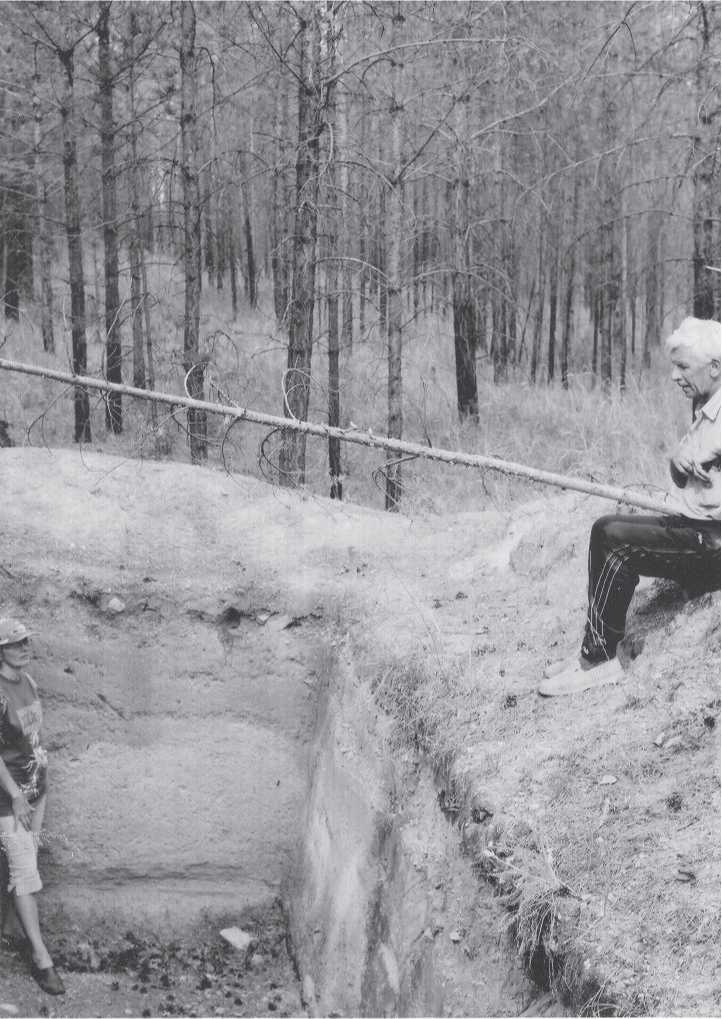The site called Varvarina Gora (Barbara’s Hill) is up-river from Kamenka, at 51°38' N, 108°10' E (Lbova 2000:153, Vasili’ev et al. 2002:528). It contains the accumulation of artifacts and faunal refuse left ca. 30 000 years ago by blade-making Upper Paleolithic hunters and their families, who camped repeatedly at the site, probably for many generations judging from its extensive refuse area. One reaches Varvarina Gora by turning off a dirt road connecting a remote and strangely out-of-place rusty factory town called Zaigraevo with a distant village by the name of Sara Bryan. At the turn off, a lightly used track winds uphill around burned stumps and new-growth forest (Fig. 3.184). Varvarina Gora is located on the lower southern slope of a conifer-covered hill overlooking the distant left bank of the northward-flowing Bryanka River.
Stone artifacts were discovered by workers constructing a power line in 1961, some poles of which had been set into the ancient site. News of the discovery of stone artifacts and bones was sent by E. A. Khamzina and D. D. Bazarov to A. P. Okladnikov, who carried out a multi-year excavation program at Varvarina Gora in the 1970s (Lbova 2000:51, Okladnikov and Kirilov 1980:31). Duringour site inspection on July 8,2003, the forest was plagued by swarms of fiercely biting large black flies that instinctively attacked faces and eyes. Were these dreadful pests present when Varvarina Gora was occupied? Ovodov recalls that they were such a severe problem when he and A. Konapotski helped A. P. Okladnikov conduct the original excavations, that they necessitated smoky fires be kept burning much of the time to drive the voracious flies away.
Ludmila Lbova (2000, 2002) discusses Okladnikov’s finds as well as her own subsequent additional excavations. She illustrates the deeper (Layer 2) and typically Upper Paleolithic artifacts recovered from the approximately 1100 m2 area excavated at Varvarina Gora, as judged fTom her site maps (Lbova 2000:178-180). Stratigraphic and archaeological evidence initially indicated a single major component (Okladnikov and Kirilov 1980, Ovodov 1987a), but Lbova’s re-excavations in 1986, 1992, and 1993 showed that there was also a later (Layer 1) 17 000 BP occupation by people who manufactured microblades and wedge-shaped cores. This later occupation overlay the earlier occupation dated 28 000 to 34 000 BP (Lbova, personal communication, July 8, 2003). Vasili’ev et al. (2002:528) list all the published dates for Varvarina Gora, which we have simplified to 30 000 BP for ease of recall. Ovodov (1987a) identified the species

Fig. 3.184 Varvarina Gora site. Ludmila Lbova (left) explains her additional work at this open site,
First tested by A. P. Okladnikov. Nicolai Ovodov (right) was a member of the original dig crew (CGT neg. Varvarina Gora 7-8-03:6).
And MNI of the faunal remains from Okladnikov’s excavations at Varvarina Gora. Among others, Ovodov recognized fox, wolf, bear, horse, rhinoceros, reindeer, bison, gazelle, spiral-horned antelope, and goat. Our taphonomic findings for Varvarina Gora follow, and have also been reported elsewhere (Turner 2010).




 World History
World History









